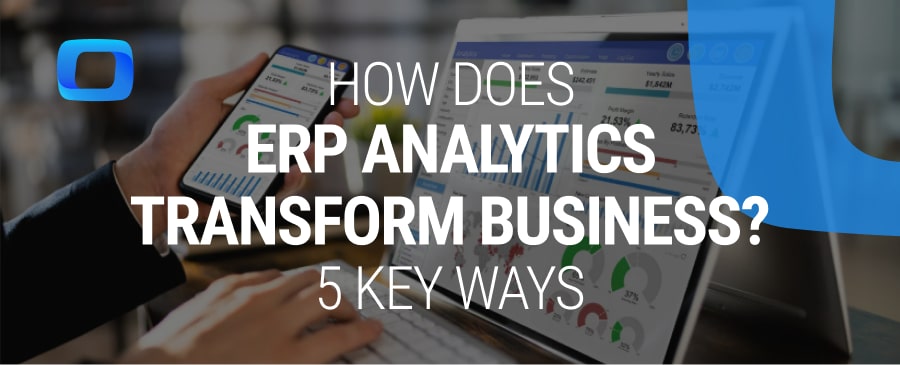Business leaders understand that success requires converting unprocessed data into useful business intelligence. Enterprise Resource Planning (ERP) systems serve as the organizational foundation, enabling organizations to effectively manage their resources and operational activities, as well as streamline process management. The actual transformation occurs when organizations implement ERP analytics solutions.

Businesses can achieve more than basic data management through analytics because they can discover patterns and predict results, and make informed strategic choices. The implementation of ERP analytics allows you to connect your business strategy with current operational performance, regardless of your company type, including manufacturing facilities and retail stores, and SaaS organizations.
Your organization can achieve optimal departmental value from analytics when you work with an ERP software development company to create customized solutions for finance and supply chain operations and all other departments.
The following article illustrates how ERP analytics enhances business operations through five key applications. The article demonstrates how analytics transforms your ERP system into a strategic leader by improving operational efficiency, enhancing decision quality, boosting productivity, and sustaining long-term business expansion.
Explore five practical ways ERP analytics reshapes business performance, from optimizing daily workflows to enhancing collaboration, improving customer satisfaction, and enabling data-backed decisions that fuel continuous growth.
ERP analytics enables organizations to achieve immediate operational streamlining as its primary advantage.

ERP analytics enables organizations to achieve immediate operational benefits through process optimization. Every organization produces extensive data collections that include sales performance metrics, production timelines, inventory quantities, employee performance metrics, and additional information. The data collection process fails to produce any useful results when organizations lack analytics capabilities.
ERP analytics connects the dots. For example:
The outcome includes shorter delays and better resource management, and decreased operational expenses. Organizations that want to stay ahead of their competition need to achieve this level of operational efficiency.
ERP analytics serves a dual purpose by organizing data while creating meaningful business insights from it. Decision-makers gain rapid access to patterns through dashboards, KPIs, and predictive models, enabling them to make informed decisions with confidence.
For example:
ERP analytics provides real-time data access, which enables leaders to make better decisions through its immediate data delivery system. Leaders obtain instant business-wide visibility through real-time ERP analytics instead of waiting for monthly reports. The system enables faster responses and risk reduction while ensuring decisions stem from data rather than instinct.
The lack of departmental integration between finance and operations, as well as HR and project management, leads to decreased productivity because each group operates independently without understanding the roles and responsibilities of the others. The single source of truth provided by ERP analytics eliminates organizational barriers between departments.

The following examples demonstrate how ERP analytics functions in actual business operations:
The automated features of ERP analytics systems decrease the need for human involvement in report generation. The time teams spend on spreadsheet compilation now allows them to perform tasks of greater value. The system enables better individual work performance and facilitates effective collaboration among different departments.
The modern customer base maintains elevated standards for service delivery, as they seek fast service, customized offers, and smooth interactions. The combination of ERP analytics enables businesses to understand customer behavior and preferences through detailed analysis of customer data.

For instance:
Companies that understand their customers' needs can develop experiences that foster customer loyalty and retention. The cost-effectiveness of retaining existing customers surpasses that of acquiring new ones, so ERP analytics generate a substantial return on investment.
ERP analytics functions as a driving force that enables sustainable business expansion. The combination of predictive models and scenario planning helps businesses to analyze various scenarios and develop effective plans for addressing upcoming challenges.
Examples include:
The system tracks the returns on investment for innovation projects to direct resources toward initiatives that generate a substantial impact. Organizations that utilize ERP analytics create their future direction, rather than simply responding to current situations.

The following examples demonstrate how ERP analytics produces quantifiable business outcomes in real-world operations.
ERP analytics provides organizations across all industries with both short-term benefits and long-term business value.
The implementation of ERP analytics for success requires careful planning, despite its evident advantages. The following steps outline the necessary procedures for successful implementation.

Organizations that adopt ERP analytics systems establish a dominant market position. The organization operates with enhanced efficiency, making superior choices, maintaining employee productivity, delivering customer satisfaction, and conducting innovation with confidence.
Traditional ERP systems alone fail to meet the demands of fast-changing markets and short-lived customer loyalty. The implementation of analytics turns basic transactional ERP systems into powerful strategic growth platforms.
Organizations at every stage of digital transformation should prioritize analytics to achieve maximum value from their existing ERP systems.

ERP analytics transforms raw ERP data into actionable insights through advanced reporting and predictive analysis, while traditional ERP systems primarily handle transaction processing and data management without offering deep analytical capabilities.

ERP analytics provides real-time dashboards, KPIs, and predictive models that unify data from finance, operations, and HR, allowing decision-makers to identify trends quickly, respond faster to changes, and make confident, data-backed business decisions.

ERP analytics boosts efficiency, enhances decision quality, increases productivity, improves customer satisfaction, and fuels long-term innovation. It transforms operational data into strategic intelligence that helps businesses optimize performance and maintain a competitive advantage.

By analyzing customer behavior, feedback, and demand patterns, ERP analytics enables businesses to offer personalized experiences, prevent service delays, and forecast customer needs, resulting in improved satisfaction, retention, and long-term customer loyalty.

Organizations should define clear goals, ensure clean data quality, choose custom analytics solutions, train employees, and begin implementation with one department to validate results before scaling analytics capabilities across the enterprise.